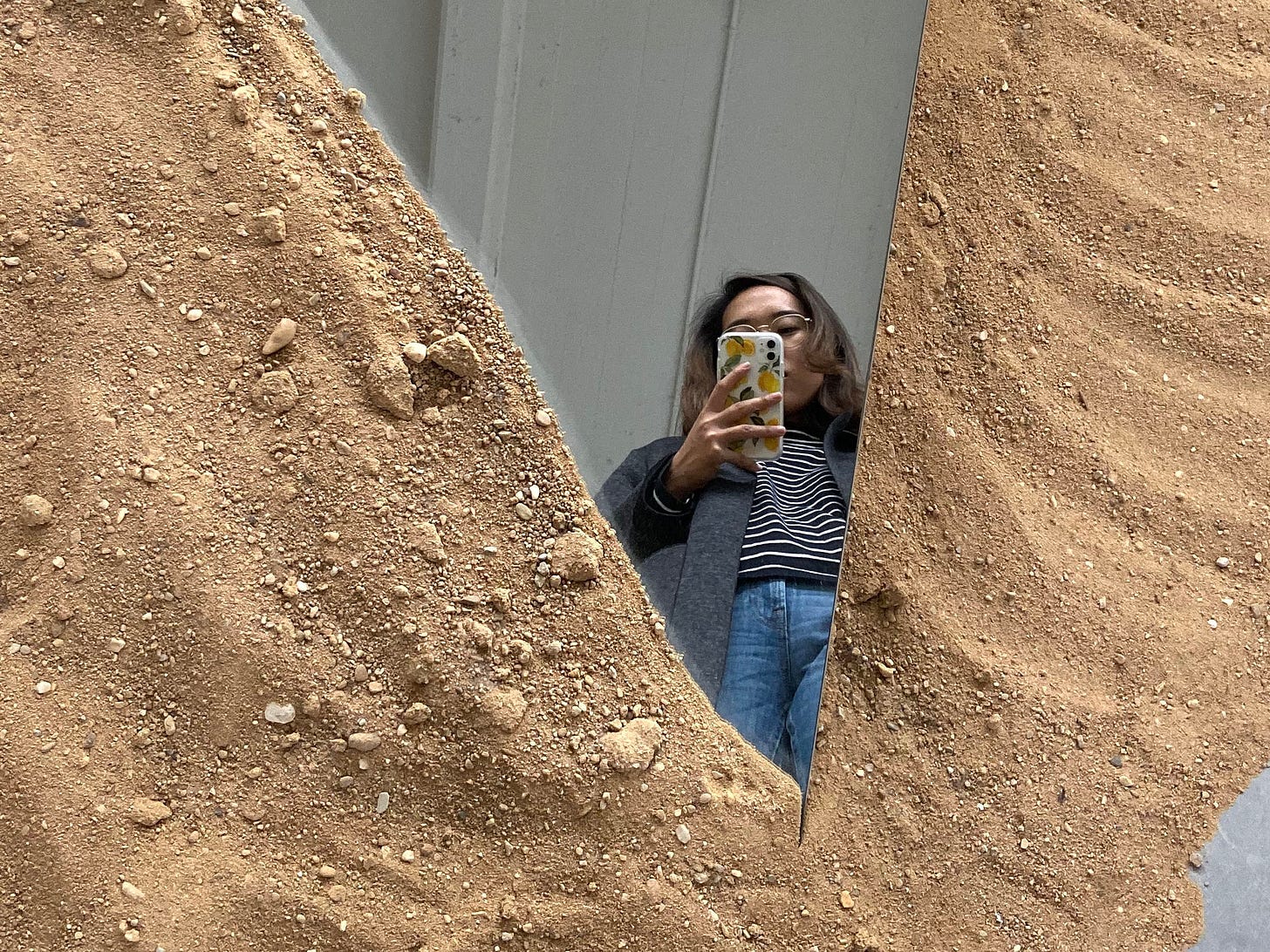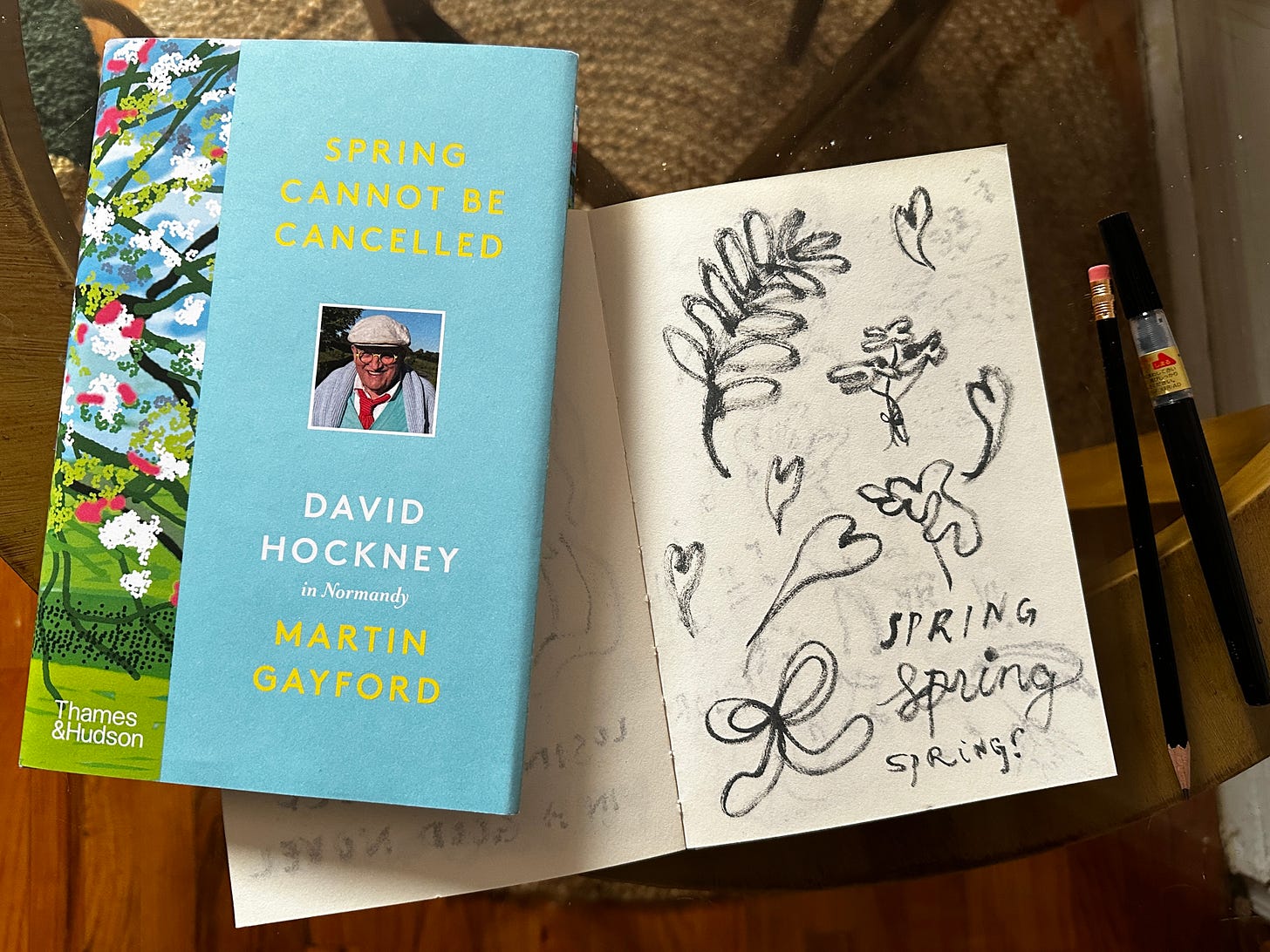Rewiring my online compulsions
My history of trying to detach from the internet, and what reframes are working for me lately
As an early adopter of the internet and a modern day tech worker, I have over twenty years of experience with compulsive online behavior. In my younger days this looked like spending hours and hours on internet fandom communities. Nowadays it’s checking my email, Slack messages, Substack comments, and Instagram notifications much more frequently than I’d like.
This is nothing to be proud of—it feels quite shameful to admit, especially as an artist who primarily finds inspiration through traditional media. But I share this embarrassing truth because I know I’m not alone. We are all floating in between earthly and online realms, sometimes veering strongly in one direction then the other.

I desire to be grounded in myself and the earth around me, not the internet portal, but the reality is that I’m waffling in between. Growing up I gravitated toward the computer, wanting to disconnect from my lonely physical being stuck at home. Learning the opposite behavior by staying present in the earthly realm takes a lot of time. The internet does not make it easy.
Once I moved to New York and got my first job in 2013, I found that I wanted to be more in the real world. The timing of this coincided with the rise of Instagram, which blurred the lines of the online and offline (if I’m seeing pictures and videos of people I know in real life, isn’t that kind of like being in the real world?) I had stopped using the online world as an escape, but now I was using it to measure my value in the physical world.
I thought I had healthy work boundaries when I removed my work email from my personal phone a week into my first job. I was lucky, in a twisted sense, to have a stressful crash course of working late hours and knowing that something needed to change if I didn’t want to stiffen into a ball of anxiety.
Then I became an engineer just as tech companies started adopting a tool called Slack, which was even more fast-paced than email. As a perennially online person it was easy for me to adopt this quick method of communication, responding to people quickly and projecting the airs of being a busy and responsible engineer. I found satisfaction in helping people through quick responses even if I hadn’t worked on challenging tasks that required more focus.
Starting in 2017, a few years into my engineering career, I dove deep into trying to draw digital boundaries. I read Deep Work and Digital Minimalism and Atomic Habits and Nir Eyal’s blog. I downloaded Freedom and RescueTime. I turned my phone screen to greyscale. I deleted Instagram from my phone.
Seven years later and I am still trying different bandaid solutions. I only download Instagram to post something then delete it after (then cave and re-download to check my notifications, then delete it again). I turn off Gmail and my web browser when I’m not on wifi. I look at Substack only through web browser and log in and out every time.
If you look at my digital usage from a numbers perspective, you could call these tactics successful. On average I use my phone 2-3 hours a day. I don’t spend a whole lot of time on Substack or Slack or email or whatever platform. But I do drain my time ruminating over whether I should check, if I can allow myself to check, or thinking about what a bad person I am after checking.
The tactics to limit usage or set boundaries may be useful, and some of them will work for a time. But they alone don’t satisfy. They don’t cure any underlying dependency on the internet to feel accomplished and worthy.
By now you’re likely wondering if this is another quitting social media essay. It is not! I’m not here to tell you to leave social media or wax poetic on the merits of leaving, though I concede there are many. Plenty of others offer guidance on leaving social media while continuing to be a working person on the internet, such as Amelia Hruby’s Off the Grid podcast and
’s Social Media Escape Club. All my love to this growing community of folks who are advocating for connection beyond social media marketing.My online compulsions are not specific to social media. I can develop an attachment for anything that engages me and makes me feel understood, even an AI chatbot. Plus, I love that I can connect with people through the jungle of wires that make up the internet! Going cold turkey is a clearly defined and appealing fix, much like the writer’s cabin fantasy. And while I would love to try longer digital detoxes, completely cutting out the internet from my life is not something I want to do.
I unloaded my issues with internet usage during a recent therapy session, as one does. After patiently listening, my therapist posed a question that gave me pause. She asked, “What if your checking wasn’t a problem you needed to solve?” What if I could be at peace with the way I was using the internet, provided I wasn’t causing myself major distress? What if it were okay to want to check my inbox more than a few times a day or check for comments on my latest newsletter? Holding tightly to my self-imposed ideas of how I should be, I struggled to open to the possibility that I might not need to fix my compulsions. Maybe I was just an average human being wanting to engage with the world in the ways I knew how.
Winter is coming to an end, and with it my rumination subsides. Instead of fixating on the “bad” this spring, I think about how I can invite in more good. What do I find more interesting than whatever is waiting for me online? How can I invite more of it? This is the time to identify the little seeds where we find genuine delight and letting them grow. My seeds these days consist of a new brush pen and an endlessly inspiring read on David Hockney’s Normandy spring series. What are they for you?
Much like our daily teeter-tottering between earthly and online realms, growing up calls for a delicate dance with self-compassion lest we spin out in our own whirlwind of spiraling thoughts. As I practice more compassion for myself, I’m learning to find empowerment in every small victory over my compulsive online urges. Rather than dwelling on what I’m missing—an itch of curiosity scratched, a feeling of anxiety relieved—I am choosing to celebrate the neural pathways I’m rewiring and the pleasures I am befriending outside of the notification screen.
My zine “How to Keep Your Hobby from Becoming a Job” continues to make its way around the world. Get it now via $4 physical copy or free digital download! Here’s a review from this week:
“In our capitalist society where everywhere you turn, someone is telling you to start a side hustle with that thing you enjoy and are good at, this was refreshing. Hobbies give me so much joy and I’m glad this reaffirmed me and gave me tips on how to enjoy my hobbies more."
A quick FYI that my shop will be closed in April as I’ll be traveling in Asia on my honeymoon 🥰 If you’ve been thinking about ordering anything, now’s the time!






I am also chronically online and I have also done all those things to try to curb my phone usage. When I moved to another country, that's how I met the majority of my friends! That's how I found things to do and places to be. And that's how I keep in touch with friends and family I left behind. The online and offline are so intertwined, going cold turkey would be not only ill-advised but also impossible. I recently made a list of things I do on my phone that 'add' to my life, and things that take away from it. And I try to stick to those that add. When I catch myself reading another crazy AITA story on reddit, I switch and read one of my favourite substackers instead and leave her a comment.
I totally get where you are coming from Carolyn. I have been online since 1996 as an entrepreneur, political blogger, writer and photographer. It's hard to step away.